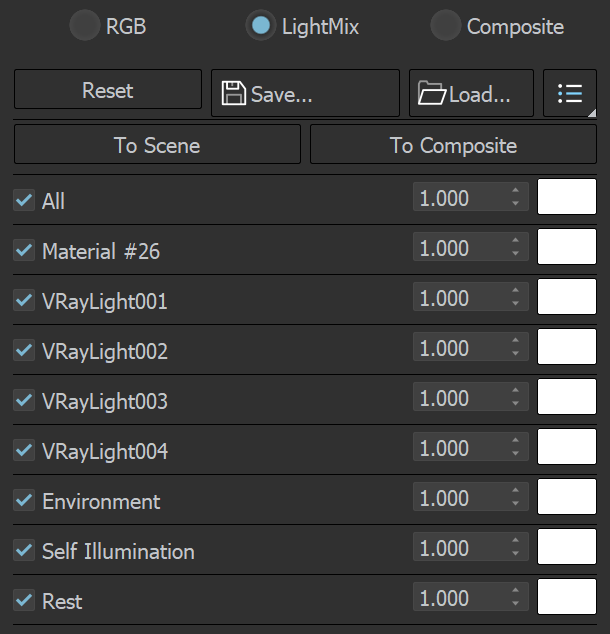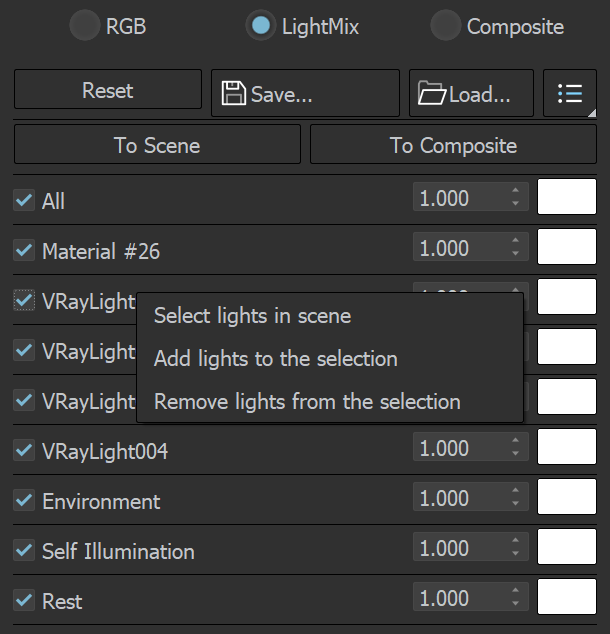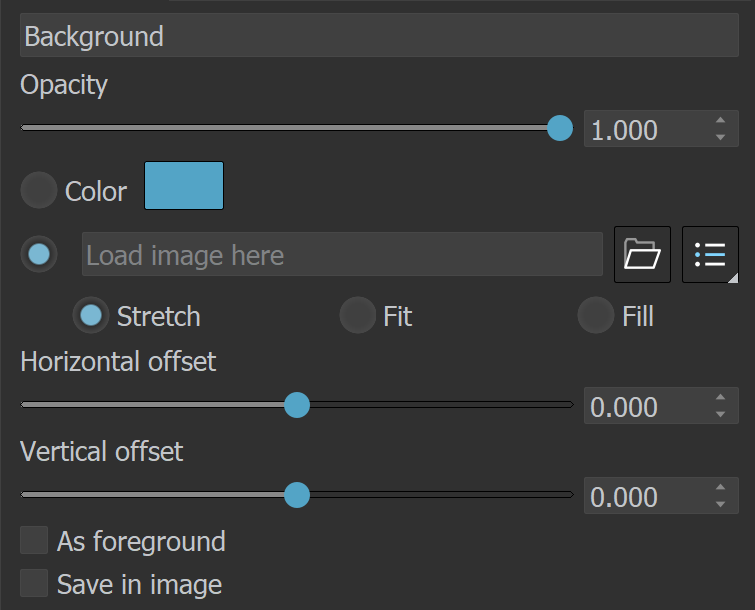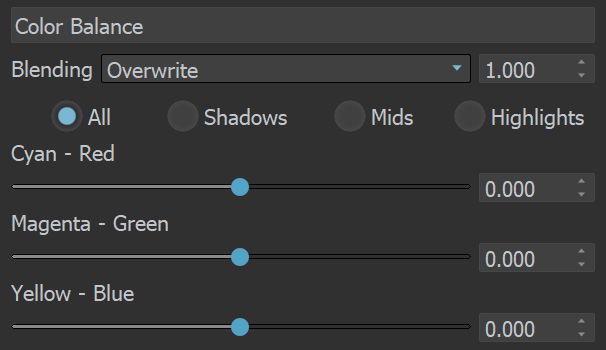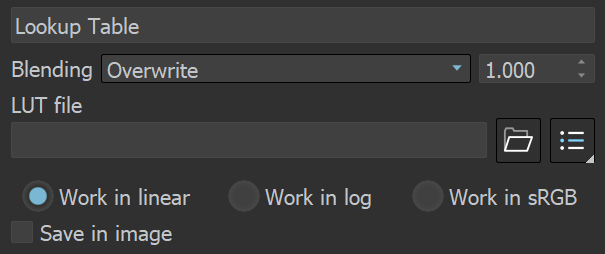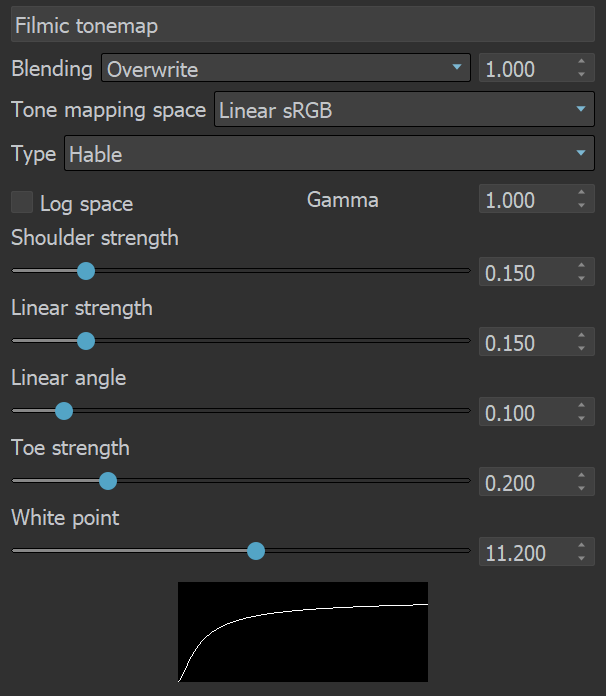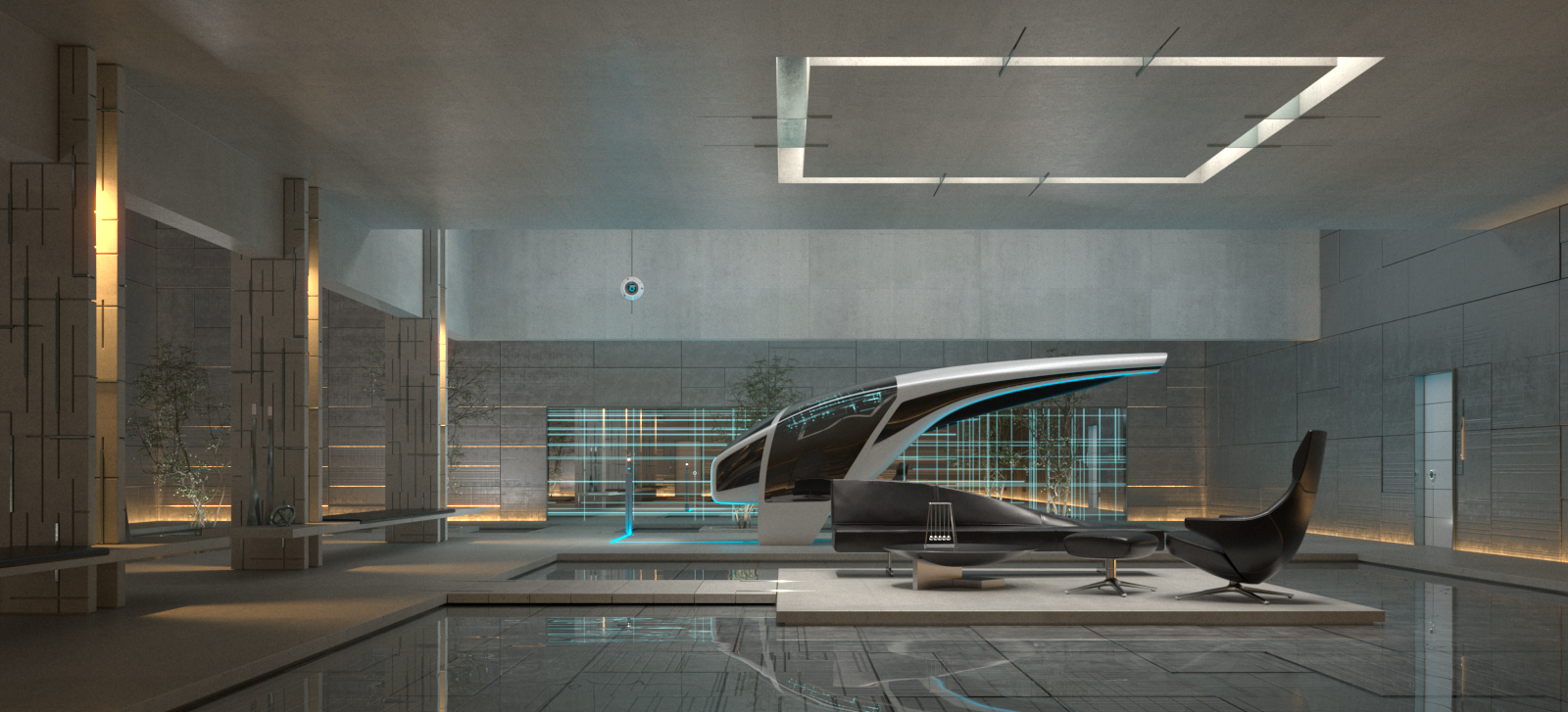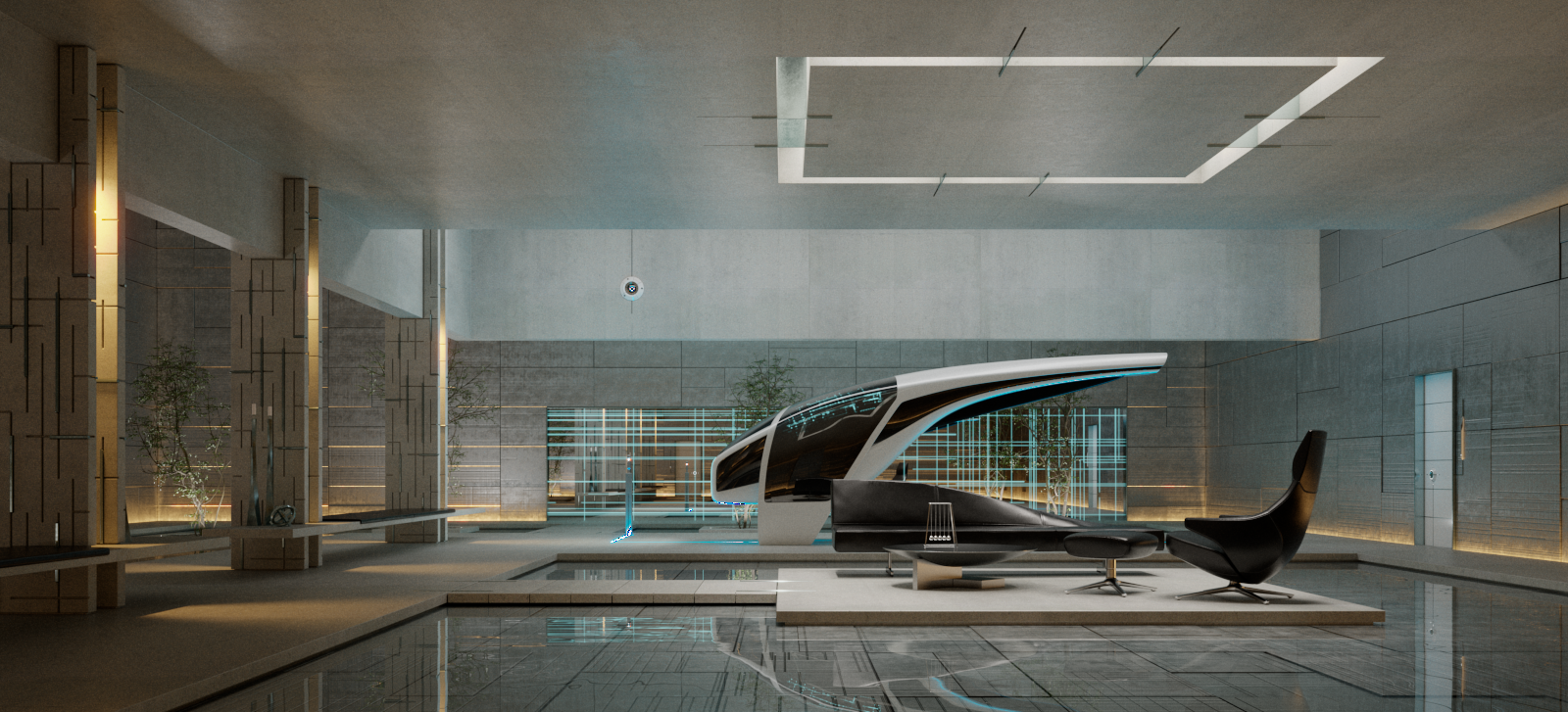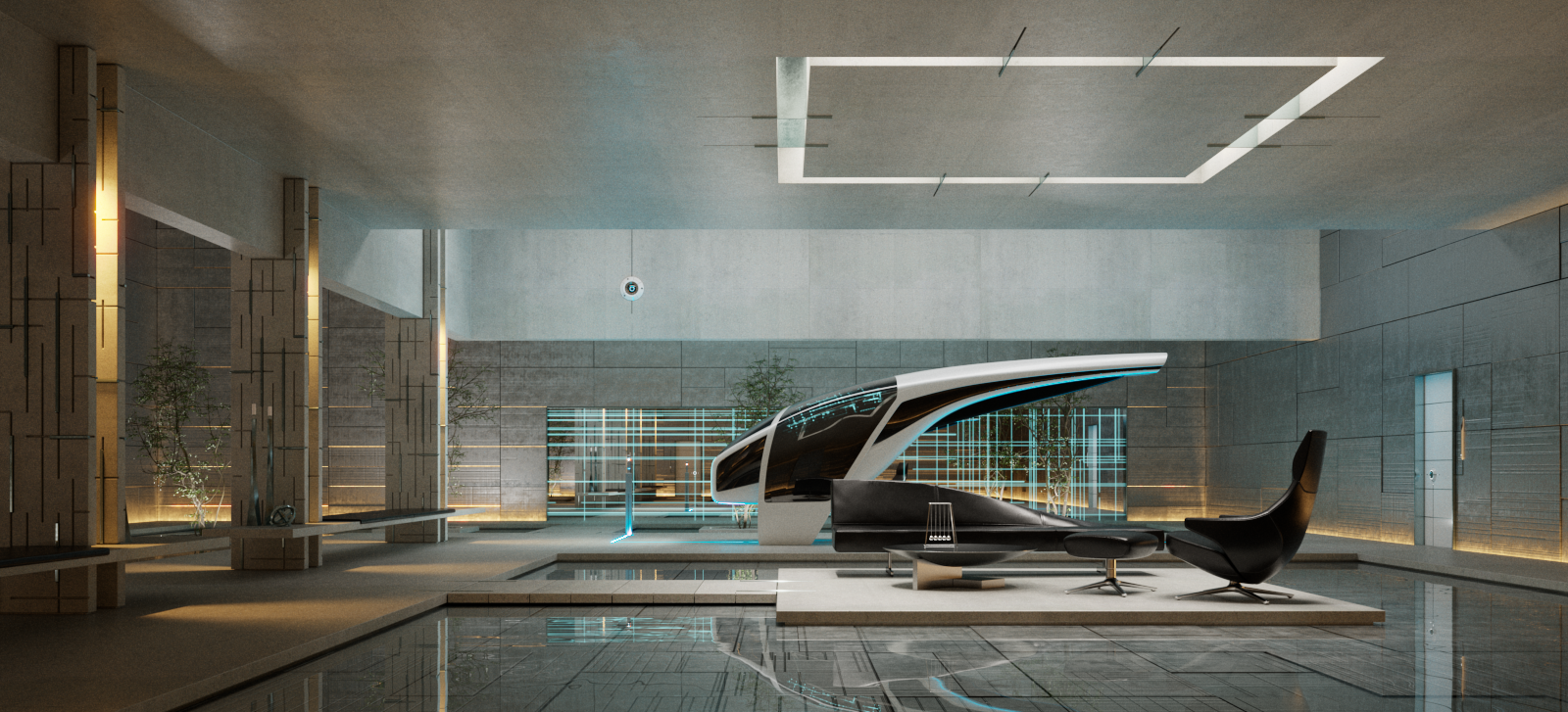This page contains information on the Layers panel in the V-Ray Frame Buffer.
Overview
Layers Menu
Commands available for the Layers panel are located at the top of the panel. Press on the icons to see the expanded list of commands for the stacked buttons.
Creates a layer. Multiple layers of the same type can be added. Folder – Allows grouping multiple layers in folders; | |
| Deletes the selected layer(s). | |
| Saves a layer tree preset. | |
| Loads a layer tree preset. | |
Quick access to custom layer presets. You must set the path to it in the VFB Settings. | |
| Undo various actions related to layers such as create, delete, reorder or modify a layer. | |
| Redo various actions related to layers such as create, delete, reorder or modify a layer. |
When the Filters/Layer presets path is not specified in the VFB settings, the system automatically reuses the most recently used save/load location.
Command | Description |
|---|---|
| Reset | Resets all changes done to the selected layer. |
| Save | Saves the layer as a preset. |
| Load | Loads a preset for the selected layer. |
| Delete | Deletes the selected layer. |
| Save all CCs as LUT | Bakes all the color corrections to a LUT file. It can be used with RMB on a Display Correction layer and saves only the corrections in its section, but ignores their masks. |
| New Layer | Creates a new layer. |
| Duplicate | Duplicates the selected layer. |
| Blend Modes | Specifies how the selected layer blends with the result from all layers below it. |
Color correction layers like Exposure and White Balance can be applied to a single layer instead of the entire composite.
You can do that by selecting a layer and then adding a new correction or by dragging the correction layer to another layer until an arrow icon appears.
The Stamp, Display Correction, Sharpen/Blur, Denoiser, Lens Effects and Source layers are listed in the Layers panel by default to any rendered image. Their order cannot be changed.
Layers can be disabled from the visibility icon (), reordered, nested, stacked in folders, etc. Disabled layers are indicated by the icon.
Corrections are applied from the bottom to the top, except for nested layers, which are executed after their parent.
Color corrections and the denoiser channel are saved in the output image just like they are applied in the VFB.
Adjustments made to the Display Correction layer are only applied for preview purposes in the VFB. Display corrections are usually saved for 8-bit image formats like JPEG and PNG and not to EXR files, which are expected to be linear.
V-Ray 7 provides precise parameter slider movement with the CTRL key and step-sliding using the SHIFT key.
Layers are only saved to .exr and .vrimg files written through V-Ray's own output. The output in Render Setup > Common tab is written by 3ds Max so .exr files saved from there do not have Layers saved.
When saving layers to an exr/vrimg file, V-Ray writes a flag indicating whether the color corrections are baked in the RGB channel. For example, if you save an exr from the VFB File menu > Save all image channels to single file option, V-Ray creates an .exr file with corrections baked in. It also saves the layers as metadata and the flag that corrections are baked in. When loading images into the Frame Buffer, V-Ray checks if the image has corrections baked (using the flag), and if such are found, the layers are not loaded because this causes double correction.
If you want to keep the layers that come with the Max scene, turn the Auto Load Layers option off from VFB > Options > History tab. If you want to load layers from an external image, enable the Auto Load Layers option and check how you save those images.
Composite Layer options
Blend modes
When adding a new layer, it is placed on top of the stack and it is considered the foreground (FG).
The result of all layers below it is considered the background (BG). Layers are applied from the bottom to the top.
Where darker and lighter pixels are mentioned below, it is in relation to mid-grey.
| Blend Mode* | Description |
|---|---|
| Overwrite | Displays the current layer (FG) on top of all layers (BG) without blending. This is the default. |
| Normal | Blends the alpha of the VRayMtlSelect render element's material and other layers. See Notes for more information. |
| Average | The average of the current layer (FG) and the result from the layers below it (BG). |
| Add | Adds the FG to the BG. |
| Subtract | Subtracts the FG from the BG. Does not affect completely black areas. |
| Divide | Subtracts the BG from the FG. Dark areas of the render are brightened, while bright areas of the render are not changed significantly. Does not affect completely white areas. |
| Darken | Compares the FG to the BG and takes the darker pixel values of the two. |
| Multiply | Multiplies the FG by the BG. |
| Color Burn | The color of the FG is applied to darker pixels in the BG. |
| Linear Burn | Same as Color Burn but with less contrast. |
| Lighten | Compares the FG to the BG and takes the lighter of the two. |
| Screen | Makes both light and dark areas lighter. |
| Pin Light | Replaces the BG colors depending on the brightness of the FG color. If the FG color is lighter than mid-gray, BG colors darker than the FG color are replaced and vice versa. |
| Difference | Compares the pixels in the BG and FG and subtracts the darker pixels from the brighter ones. |
| Exclusion | Same as Difference but with less contrast. |
| Hue | Uses the hue from the FG , while the value and saturation are taken from the BG. |
| Saturation | Uses the saturation from the FG, while the value and hue are taken from the BG. |
| Color | Uses the hue and saturation from the FG, while the value is taken from the BG. |
| Value | Uses the value from the FG, while the hue and saturation are taken from the BG. |
| Hard Mix (8bit) | Adds the FG to the BG and for each color component returns a value of 255 if the result is 255 or greater, or returns 0 if the result is less than 255. |
| Color Dodge (8bit) | The color of the FG is applied to lighter pixels in the BG. |
| Linear Dodge (8bit) | Same as Color Dodge but with less contrast. |
| Spotlight (8bit) | Same as Multiply, but with twice the brightness. |
| Spotlight Blend (8bit) | Same as Spotlight, but additionally brightens the BG. |
| Overlay (8bit) | Darker pixels become darker where the BG is dark and brighter pixels become brighter where the BG is bright. |
| Soft Light (8bit) | Darker pixels become darker where the FG is dark and brighter pixels become brighter where the FG is bright. |
| Hard Light (8bit) | Spotlight is applied to pixels where the FG is dark and Screen is applied to pixels where the FG is bright. |
* All 8-bit blend modes clamp colors to a maximum value of 1.0.
Proportion Guide
Stamp
Masks
Display Correction
Normally you would specify the ICC file for your calibrated monitor here. Programs like PhotoShop display images using your (primary) monitor's ICC profile automatically. However (at least for the moment), 3ds Max is not a color-managed application and you must manually load the monitor ICC profile into the V-Ray frame buffer in order to match the appearance of your images in PhotoShop.
The Display Correction layer cannot be removed or reordered. It is always applied on top of all other layers, as it specifies the display color space of the resulting image or composite in the frame buffer.
The Exposure slider in the Display Correction layer is only for display purposes and is not saved when writing to files.
OpenColorIO (OCIO)
ICC
ICC Profile
Source
LightMix Mode
Vignette
Lens Effects
Sharpen/Blur
Denoiser
Background
Constant
Exposure
White Balance
Hue/Saturation
Color Balance
Curves
To create a point, select the Picker, then go to Render View and click. Hold click + mouse move to create and move the point.
When working with .acv files, some approximations are performed because the curves in the .acv files are described by a different mathematical formulas.
Lookup Table
Filmic Tonemap
Example: Filmic Tonemap Layer Added
Filmic Tonemap layer is disabled
Filmic Tonemap layer is enabled
Example: Filmic Tonemap Types
Linear
Hejl-Dawson
AMPAS
Hable
Power Curve
Example: Fine-tune VRayLightMtls in post in VFB
Example: Apply Masks in VFB
This video shows you how to apply masks on Lens Effects and Denoiser in the VFB.
Notes
- Color corrections in RGB mode are applied to all Beauty render elements and some Utility render elements too. They are not applied to render elements that present masks or hold geometry or computational data for the rendered frame.
- Alpha blending is possible by using the VRayMtlSelect render element. When blending between the VRayMtlSelect layer and other layers using the Composite source, set the Blending mode to Normal to take Alpha into consideration.























